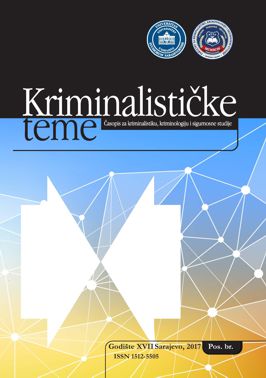MAPIRANJE KRIMINALITETA U BOSNI I HERCEGOVINI - STANJE I PERSPEKTIVE
CRIME MAPPING IN BOSNIA AND HERZEGOVINA - CURRENT SITUATION AND PROSPECTS FOR THE FUTURE
Author(s): Muhamed Budimlić, Muamer Kavazović, Predrag Puharić, Sandra KobajicaSubject(s): Maps / Cartography, Criminal Law, Criminology, Social Norms / Social Control, ICT Information and Communications Technologies
Published by: Fakultet za kriminalistiku, kriminologiju i sigurnosne studije Univerziteta u Sarajevu
Keywords: Crime mapping; geographical information systems; police agencies; Bosnia and Herzegovina;
Summary/Abstract: Reason(s) for writing and research problem(s): It is becoming increasingly more difficult for traditional systems of operational and analytical work to respond to types of criminality encountered today thus because they are unable to provide accurate data in sufficient time to predict trends and provide support to the decision making process. Geographical Information Systems (GIS) use computer-processed geographical maps as an aid to visualize and access large amounts of data that are located within specific databases. In this way, the work of police agencies with respect to critical information detection process and in particular those events related to criminal trends has become significantly easier and more quickly. This means that GISs are an important means of combating criminality, because of their tools for crime mapping and analysis. In addition, these systems provide an analysis of complex and at first sight unrelated events displayed on multiple layered area maps. Goals of this paper (scientific and/ or social): In preventing and combatting crime, GISs can be used in three different areas: crime mapping, crime analysis and investigation and finally pre-investigation work. In this paper, the authors will discuss all three aspects of GIS usage, focusing on its capabilities and advantages in improving crime control in society. Methodology/ Design: In order to achieve these goals, it will be necessary to conduct specific theoretical research focusing on crime mapping categories, including the legal framework and the norms regulating this area. In addition, the authors will perform empirical research of an appropriate sample of institutions are likely to use crime mapping in their work, and will also apply quantitive and qualitive analysis methods based on the empirical material. The initial theoretical basis of the work will be presented by focusing on environmental criminology. However, other concepts of criminalistics and other sciences either within or outside of criminology will also be taken into consideration. Research/ Paper limitations: The main limitation of this research might be the limited practical use of crime mapping within institutions dealing with formal social control, and reluctance of supervisors within these institutions to improve efficiency by introducing new technologies and methods, as was found in some recent research in the organization and functioning of police and judicial institutions.
Journal: Kriminalističke teme – Časopis za kriminalistiku, kriminologiju i sigurnosne studije
- Issue Year: XVII/2017
- Issue No: 5
- Page Range: 11-30
- Page Count: 20
- Language: Bosnian, Croatian, Serbian

